Human pregnane X receptor activation and CYP3A4/CYP2B6 induction by 2,3-oxidosqualene:lanosterol cyclase inhibition
- PMID: 19158313
- PMCID: PMC2680536
- DOI: 10.1124/dmd.108.025130
Human pregnane X receptor activation and CYP3A4/CYP2B6 induction by 2,3-oxidosqualene:lanosterol cyclase inhibition
Abstract
The effects of [4'-(6-allyl-methyl-amino-hexyloxy)-2'-fluoro-phenyl]-(4-bromophenyl)-methanone fumarate (Ro 48-8071), an inhibitor of 2,3-oxidosqualene:lanosterol cyclase (cyclase), were evaluated on CYP3A4 and CYP2B6 mRNA content in primary cultured human hepatocytes. In seven hepatocyte culture preparations, 24-h treatment with 3, 10, or 30 microM Ro 48-8071 produced median increases in CYP3A4 mRNA content that were 2.2-, 7.1-, and 8.5-fold greater than untreated control, respectively, and produced increases in CYP2B6 mRNA content that were 3.0-, 4.6-, and 3.4-fold greater than control, respectively. Increases in CYP3A4 immunoreactive protein content were also measured in Ro 48-8071-treated hepatocytes. To evaluate the effects of cyclase inhibitor treatments further, a pregnane X receptor (PXR)-responsive transactivation assay in HepG2 cells was used. Ro 48-8071, trans-N-(4-chlorobenzoyl)-N-methyl-(4-dimethylaminomethylphenyl)-cyclohexylamine (BIBX 79), and 3beta-(2-diethylaminoethoxy)androst-5-en-17-one HCl (U18666A) induced luciferase expression from a PXR-responsive reporter with EC(50)s of 0.113, 0.916, and 0.294 microM, respectively. Treatment of the HepG2 system with (E)N-ethyl-N-(6,6-dimethyl-2-hepten-4-ynyl)-3-[(3,3'-bithiophen-5-yl)methoxy]benzenemethanamine (NB-598), an inhibitor of squalene monooxygenase, at concentrations sufficient to achieve cholesterol biosynthesis inhibition significantly inhibited cyclase inhibitor-mediated, but not rifampicin-mediated, reporter induction. Direct treatment of the HepG2 system with 1 to 10 microM squalene 2,3:22,23-dioxide, but not squalene 2,3-oxide, significantly activated PXR-responsive reporter expression. Also, squalene 2,3:22,23-dioxide bound to human PXR in vitro with an IC(50) of 3.35 microM. These data indicate that cyclase inhibitors are capable of producing CYP3A4 and CYP2B6 induction in primary cultured human hepatocytes, and that an endogenous squalene metabolite is a conserved intracrine activator of PXR.
Figures
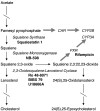


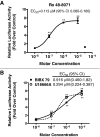
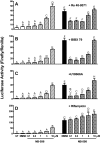
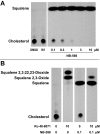
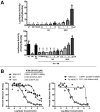
References
-
- Fang HL, Strom SC, Ellis E, Duanmu Z, Fu J, Duniec-Dmuchowski Z, Falany CN, Falany JL, Kocarek TA, and Runge-Morris M (2007) Positive and negative regulation of human hepatic hydroxysteroid sulfotransferase (SULT2A1) gene transcription by rifampicin: roles of hepatocyte nuclear factor 4alpha and pregnane X receptor. J Pharmacol Exp Ther 323 586–598. - PubMed
-
- Furster C and Wikvall K (1999) Identification of CYP3A4 as the major enzyme responsible for 25-hydroxylation of 5β-cholestane-3α,7α,12α-triol in human liver microsomes. Biochim Biophys Acta 1437 46–52. - PubMed
Publication types
MeSH terms
Substances
Grants and funding
LinkOut - more resources
Full Text Sources
Research Materials

